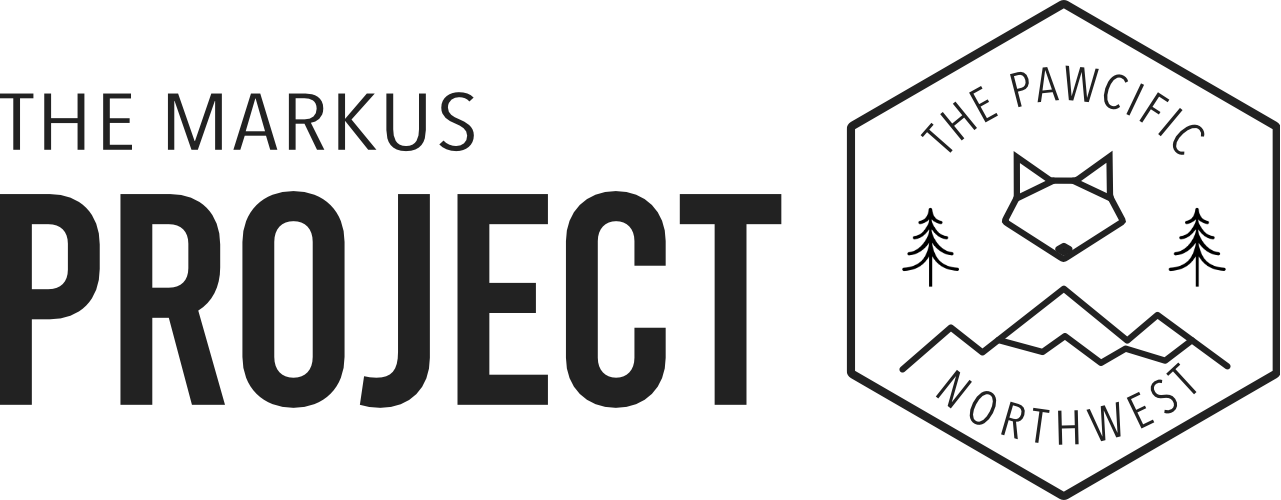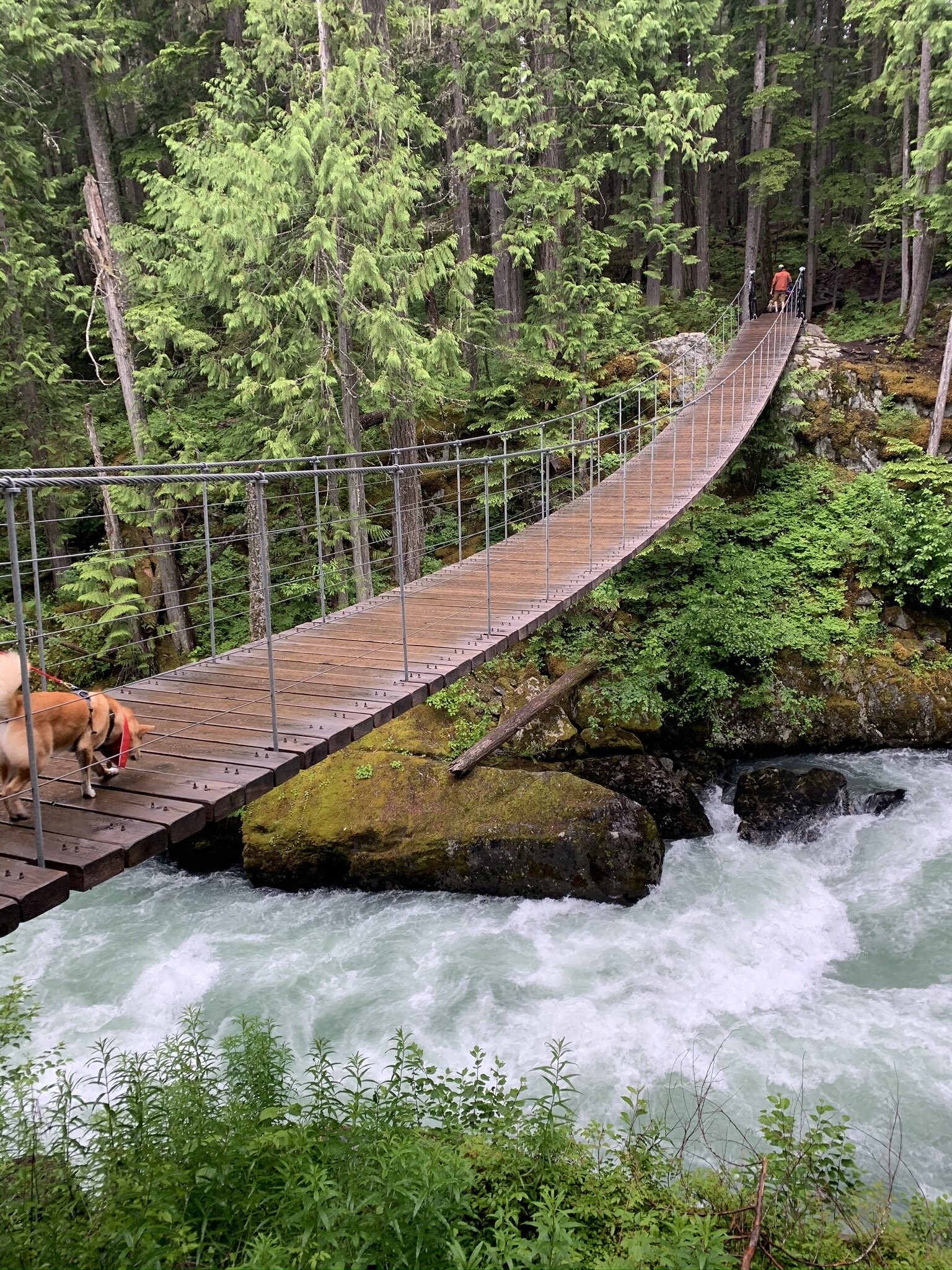Train Wreck Trail
Markus posing in front of a crashed boxcar with graffiti on the Train Wreck Trail
As of the time of this writing, we're a few months into the global COVID-19 pandemic and we've been unable to do much traveling with Markus. In British Columbia, we recently moved into Phase 3 of the restart plan, which allows for non-essential traveling within the province so we took the opportunity to take a mini-trip up to Squamish, British Columbia. On this trip, we visited a number of parks and trails including one of our favourite hikes that we've done with Markus to date, the Train Wreck Trail.
About the Train Wreck Trail
Markus carefully crossing the suspension bridge along Train Wreck Trail
The Train Wreck Trail was an unofficial and slightly longer trail until more recently. To get to the site of the train wreck, a large number of hikers would trespass through the back of private buildings hoping to get a glimpse of the train wreck. A suspension bridge was put up which allows hikers to cut through the Cheakamus River instead, avoiding having to trespass through private property.
The scene at the end of the hike is something to behold and feels almost surreal. Instead of the viewpoints or waterfalls that we're so used to at the end of a trail in British Columbia, the Train Wreck trail takes you to a site of an iconic train wreck from 1956. The boxcars from the train wreck have since been colourfully painted and there's something special - almost beautiful - about this train wreck that's become a work of art.
The Train Wreck Trail
Type: Trail
Length: 2 km
Traffic: Heavy
Route Type: Out & Back
Markus hiking through the forest of the Train Wreck Trail
The actual trail is similar to the trails that we're familiar with in British Columbia. What makes this path special is the newly built suspension bridge and of course the scene at the end of trail, which makes it all worth it. Since the Train Wreck Trail is now recognized as an official trail, there's a decent sized parking lot at the trailhead.
Right by the trailhead, there's a dedicated parking lot across the street with quite a few parking spots. Even then, the parking lot was pretty full by the time we had gotten there and we were fortunate to find a spot. Because the trail's a lot easier today and we don't have to break the law to visit the site of the train wreck, it is an extremely popular and heavily trafficked trail today.
The trail is appropriate for both dogs and children. When we were there, school busses of children who were not much older than 5 years old were arriving and doing the trail as a field trip. We passed by a few groups of children like this, so you can get an idea of how easy the trail is. There were also lot of dogs on the trail, some of whom were off-leash.
Markus trying to avoid the flipped boxcar of the Train Wreck Trail
In British Columbia, we're used to hiking to a viewpoint or to see a waterfall, but this trail takes you to the site of an iconic train wreck from 1956. Since then, the destroyed boxcars have been painted over with graffiti and the site now feels like an art installation. Visitors are free to walk right into the boxcars, that have been there over 60 years. Along with the suspension bridge, these are the main attractions of the hike. From the train wreck site, you'll have to turn around and start heading back the way you came.
One issue that we had with the trail was that there were a lot of cyclists. With the regular hikers, children and dogs, the trail is busy to begin with and the number of cyclists whizzing past actually made it a little stressful for us. Most of the cyclists were respectful, but there were a few who were going faster than we were comfortable with considering the number of children and dogs on the trail. Just be aware of this.
What we liked
The train wreck site at the end of the trail is eerily fascinating. We recommend reading up on the history of it before visiting the site, which adds another layer to the hike.
The suspension bridge is also very nice and we liked that it was made of wooden (as opposed to the metal grated bridges which we find dogs not to like).
The hike itself is fairly easy.
What we didn't like
It's very congested both along the hike and at the end where the train wreck site is.
The number of cyclists were beyond what we were comfortable with. With the number of children and dogs on the trail, there were too many groups of 4 or 5 cyclists at one time and it made doing the trail quite uncomfortable as we had to constantly pull Markus off to the side to let these groups of cyclists through.
Our Recommendation for Reactive Dogs
Although this is an easy trail to do with a unique scene at the end, there are a few things to keep in mind if your dog is reactive. First, we came across a few off-leash dogs even though dogs are supposed to be on-leash while they're on the trail. Unfortunately, some owners just don't follow this rule because their dog is "friendly" and they don't realize the position that they could be putting you in.
There are some parts of the trail that are quite narrow such as the suspension bridge, but there's enough space on both ends to stand off and wait until the bridge isn't as busy before crossing. The train wreck site gets pretty congested as well and we couldn't move around too much without coming across other people, children or dogs. Keep in mind that the site is pretty close on the other side suspension bridge.
Because this trail is easy to do, it gets really busy with children and cyclists. Please keep this in mind if your dog is reactive to people, especially younger children. At the end of the day, the trail is really unique and fun to do so I would try to go earlier in the day before it gets too busy. If you don't have another choice but to go when it's busy, I would just be very cautious and aware of what's around you.
Disclaimer
Markus is a reactive, but not aggressive dog. His instinct is to avoid other dogs and he may growl, bark or lunge if provoked, but will not attack. We normally do not have issues with leashed dogs when both sides are controlled, but we will be on guard when an oncoming dog is not leashed. There are varying levels to a dog’s reactivity and only you can decide if this park, trail or hotel is appropriate for your dog. Our visits generally will not include off-leash areas; most experiences shared on The Markus Project are within leashed or undefined areas.
Please remember that our past experience visiting a park, trail or hotel may not be the same as your experience at the same park, trail or hotel. We have no control of who visits the park and whether they adhere to park rules - like leashing their dogs on leash-required paths - or not. Please use your discretion with the information provided and with your personal knowledge of your dog’s reactivity when visiting these parks, trails or hotels.




